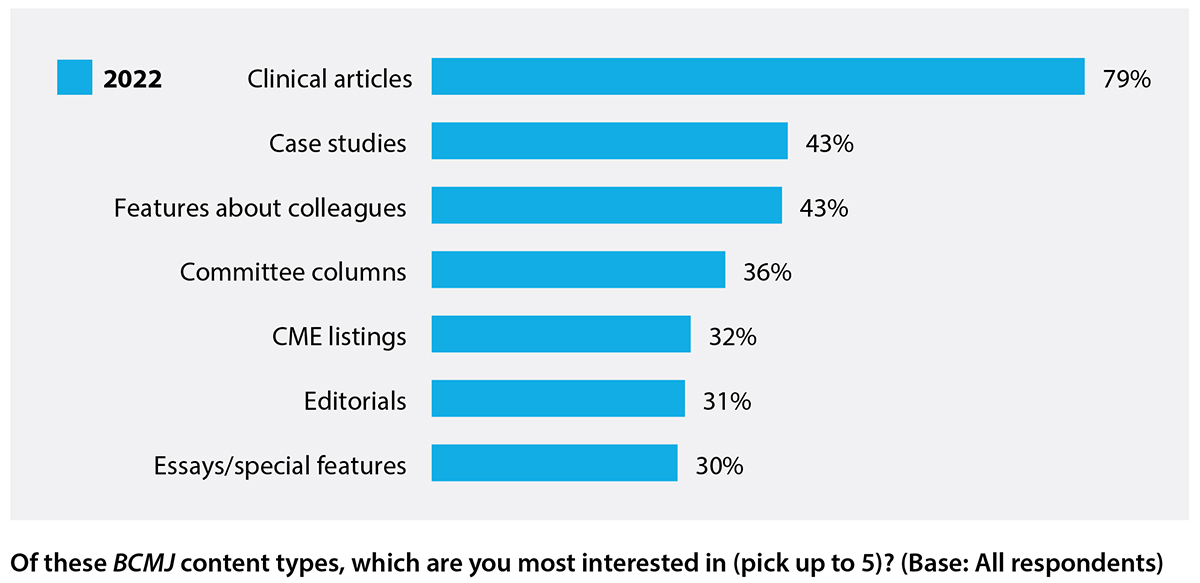BCMJ survey results 2022: What we heard
In January the BCMJ conducted an online readership survey to gauge how well the journal is meeting the needs of BC doctors. We conduct these surveys approximately every 5 years to explore new ideas and ensure the journal is succeeding in its mission.
The 1400 responses we received were from a mix of physicians (39% family physicians, 37% specialists, 13% students/residents, 11% retired) across the age spectrum, so we are confident that these findings are representative. Here are some of the key findings (percentages have been rounded to the nearest whole number).
 Print and web
Print and web
In 2016 we asked doctors whether they read the BCMJ in print or online, and we were surprised at how many chose print (92%), a preference that held regardless of age. This year, while there was some change, print’s dominance over online remains—82% of respondents continue to read the print version, with 18% choosing online.
The majority of respondents (63%) who read the BCMJ in print never go to the website, with the remaining 37% going at least occasionally. Of those who use the website, a significant number (approximately 40%) visit monthly or more often to find and read content.

 The BCMJ’s niche
The BCMJ’s niche
Readers’ favorite content type continues to be clinical articles, head and shoulders above the rest at 79% of people’s top five favorite sections. Case studies, features about colleagues, committee columns, CME listings, editorials, and essays/special features are also favorites. These findings hold when the survey data are sorted by frequency of reading, practice type, age, and setting (i.e., whether in a community, hospital, or academic setting). A strong majority of members believe that the BCMJ is a good place to have physicians’ voices shared (66% agree) and a good place for learning about what is happening in medicine in BC (76% agree).
This survey shows that the BCMJ’s niche is BC medicine—it’s where members feel the journal is the strongest, the most useful, and the most relevant. The 2022 survey confirms our impression that the journal acts as a “doctors’ lounge” (as one respondent said in the comments), a comfortable place where doctors go to hear from colleagues, pick up some best practices, and learn about changes in the medical system here in British Columbia.

 Apps and social media
Apps and social media
The survey revealed that BC physicians are increasingly using their smart phones when looking for BC medical news or articles online (31%, up from 20% in 2016). We asked whether physicians would use an app to make reading the BCMJ on their phone easier. Forty-six percent of readers said “no,” 33% were in favor of an app, and 21% were undecided.
Those who responded to the survey have little use for social media for professional reasons (12%), though personal use is higher, with 49% using Facebook and 36% using Instagram. In fact, more doctors report not using social media at all (29%) than using Twitter (21%).
 Room for improvement
Room for improvement
Overall we found that survey respondents are a little less satisfied with the journal compared with 2016 results. Though the BCMJ is a general medical journal that seeks to be useful to all BC physicians, it cannot satisfy everyone all the time because BC physicians are not homogenous. The survey results underscore this: there are passionate comments for and against print, those telling us to carry on with climate and social justice issues and those telling us to stay out of them, those who think the covers are wonderful and those who think otherwise.
 Methodology
Methodology
This online survey was completed by 1403 physicians of a possible 15 561 active, full Doctors of BC members, students, residents, and retired members. This provides a 9% response rate, estimated to be valid 19 times out of 20, within a margin of +/− 2.50%. Participants were given the opportunity to enter an optional draw to win one of two AirPods Pro as an incentive to participate. The survey was conducted 17–31 January 2022 by TWI Surveys.
hidden
 |
| This work is licensed under a Creative Commons Attribution-NonCommercial-NoDerivatives 4.0 International License. |
